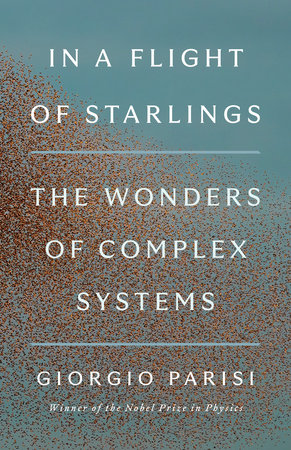In a Flight of Starlings: The Wonders of Complex Systems
- By Giorgio Parisi
- Penguin Press
- 144 pp.
- Reviewed by Carr Harkrader
- August 23, 2023
The intriguing science behind our endless connectedness.

I am more willing than most people to talk with a stranger on an airplane but can understand wanting to avoid it. You’re angled into your pinched seat, and your seatmate starts telling you stories, at best, of unknown grandchildren and, at worst, vaguely offensive opinions about women in the military or crime in Chicago. You stare at the seat back in front of you, stifle a sigh, and try to disassociate — all the while hoping your neighbor catches a clue and has some Excel sheets to poke around in.
However, after reading In a Flight of Starlings, I know one person who I’d be happy to hear ramble on and on about subjects I know little about. Giorgio Parisi has written a slim, flight-length primer on the ways that “scientists toil, doubt, succeed, and fail.” He’s in a good position to expound on all that. A prominent Italian scientist in the field of statistical physics, Parisi won the 2021 Nobel Prize in Physics for his “discovery of the interplay of disorder and fluctuations in physical systems from atomic to planetary scales.”
This book is, in part, his attempt to “make the public aware of what science is and how science and culture are intertwined,” especially considering major societal issues like climate change and the covid-19 pandemic. My last formal science education was an astronomy class in college (I got a C+), but I was intrigued by Parisi’s goal of explaining how science and culture intertwine.
Did I understand it all? No, I did not. The first two chapters, covering Parisi’s interest in the group behavior of starlings (and what it can tell us about complex systems in general) and his own start in physics in Rome during the politically tumultuous 1960s, were straightforward enough. He writes charmingly about complicated scientific theories; his prose style could be described as bushy-eyebrowed — professorial but with a mischievous hint.
The next few chapters, where he dives deeper into his own research into concepts like spun glass and collective mutations, are a bit denser, and the pages start to fill with small charts and graphs. I know these were supposed to be helpful, but I couldn’t tell which from what after a few of them. However, by this point, the author had proved himself a compelling teacher, and I wanted to be a good student.
So, I did what every novice does in this situation: I googled him. I found a video of his Nobel lecture and told myself I’d watch it. However, while there was closed captioning, it was only in Italian (fair enough), and there were even more (and more daunting) charts in his video presentation than in his book. Foiled!
I watched about five minutes of it before being distracted by a series of articles about Parisi’s controversial statements about cooking pasta. Finally, something I could understand. Earlier this year, he suggested that when cooking pasta, one should turn the burner off after adding the noodles to boiling water. This would limit energy consumption, thus saving money for energy-depleted Italians and reducing overall carbon emissions in the process. Italian chefs, however, were aghast. They said the pasta produced would be rubbery and “a disaster.” One Michelin-starred chef even commented: “Let’s leave cooking to the chefs while physicists do experiments in their lab.”
Obviously, this gourmand hadn’t read In a Flight of Starlings. If he had, he’d know the line between science and everything else we value as a society is connective, not separating. For, even with my limited insight into the dynamics of magnetic interactions or the basics of combinatorial calculus (a term wisely left off the book’s cover), I did grasp the main thrust of Parisi’s argument: We live in an intricate web of ever more complicated dynamics, but that web is shaped, stretched, and spun by our little choices and chats. As he writes about the birds that give the book its title:
“The interaction between starlings depends not so much on the general distance between them as on the connections between the closest birds.”
We see these thick flocks — or murmurations — in the air, making those swoops and turns seemingly as one body. But they are not one body, they are hundreds. One bird is reacting to the bird next to it; the bird next to that one is doing the same. And on and on.
In her novel The Waves, Virginia Woolf wrote about something similar occurring among a group of young friends: “The complexity of things become more close…What am I? I ask. This? No, I am that. Especially now, when I have left a room, and people talking, and the stone flags ring out with my solitary footsteps, and I behold the moon rising, sublimely, indifferently, over the ancient chapel — then it becomes clear that I am not one and simple, but complex and many.” Woolf recognized something deeply felt and shimmering amongst us; Parisi, with his own tools, recognizes the same thing.
Carr Harkrader is a writer and book critic in Chicago. You can follow him on Twitter at @CarrHark.

